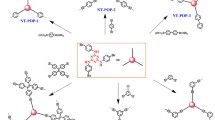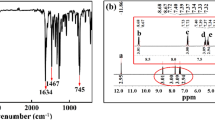Abstract
Over the past few decades, porous organic polymers (POPs) materials have exhibited great application potential in volatile radioactive iodine capture field for their porosity structures and feasible functional networks. However, the iodine adsorption capacities of POPs are still needed to improve through efficient molecule structure design strategy. Herein, we report a novel nitrogen-rich porous organic polytrazine (HCPOT-In) containing pyridine and indole units was designed and synthesized by a simple one-step Lewis acid-catalyzed Friedel–Crafts reaction of 2,6-di(1H-indol-1-yl)pyridine and 2,4,6-trichloro-1,3,5-triazine. The derived HCPOT-In showed permanent porosity and good stability. Taking advantages of the strong host–guest interaction from the porosity structure, nitrogen-rich skeleton and π-conjugated network, HCPOT-In showed the excellent volatile iodine adsorption capacity up to 4.08 g g−1 (348 K, 1 bar) with high amount of per unit SBET (14.6 wt%) and also great carbon dioxide capture performance of 120 cm3 g−1 (1 bar, 273 K). We hope this report will provide a molecular structure design idea in constructing novel POPs as efficient adsorbent materials applying in environment protection field.








Similar content being viewed by others
References
X. He, S.-Y. Zhang, X. Tang, S. Xiong, C. Ai, D. Chen, J. Tang, C. Pan, G. Yu, Exploration of 1d channels in stable and high-surface-area covalent triazine polymers for effective iodine removal. Chem. Eng. J. 371(10), 314–318 (2019)
T. Geng, C. Zhang, M. Liu, C. Hu, G. Chen, Preparation of biimidazole-based porous organic polymers for ultrahigh iodine capture and formation of liquid complexes with iodide/polyiodide ions. J. Mater. Chem. A. 8(5), 2820–2826 (2020)
J. Xia, L. Zhang, M. Qian, Y. Bao, J. Wang, Y. Li, Specific light-up pullulan-based nanoparticles with reduction-triggered emission and activatable photoactivity for the imaging and photodynamic killing of cancer cells. J. Colloid Interface Sci. 498(20), 170–181 (2017)
M. Janeta, W. Bury, S. Szafert, Porous silsesquioxane–imine frameworks as highly efficient adsorbents for cooperative iodine capture. ACS Appl. Mater. Interfaces 10(23), 19964–19973 (2018)
Z. Yan, Y. Yuan, Y. Tian, D. Zhang, G. Zhu, Highly efficient enrichment of volatile iodine by charged porous aromatic frameworks with three sorption sites. Angew. Chem. Int. Ed. 54(43), 12733–12737 (2015)
X. Guo, Y. Tian, M. Zhang, Y. Li, R. Wen, X. Li, X. Li, Y. Xue, L. Ma, C. Xia et al., Mechanistic insight into hydrogen-bond-controlled crystallinity and adsorption property of covalent organic frameworks from flexible building blocks. Chem. Mater. 30(7), 2299–2308 (2018)
Q.-Q. Dang, X.-M. Wang, Y.-F. Zhan, X.-M. Zhang, An azo-linked porous triptycene network as an absorbent for co2 and iodine uptake. Polym. Chem. 7(3), 643–647 (2016)
M. Kyotani, S. Matsushita, T. Nagai, Y. Matsui, M. Shimomura, A. Kaito, K. Akagi, Helical carbon and graphitic films prepared from iodine-doped helical polyacetylene film using morphology-retaining carbonization. J. Am. Chem. Soc. 130(33), 10880–10881 (2008)
J. Zhou, S. Hao, L. Gao, Y. Zhang, Study on adsorption performance of coal based activated carbon to radioactive iodine and stable iodine. Ann. Nucl. Energy 72(12), 237–241 (2014)
Z. Li, H. Li, D. Wang, A. Suwansoontorn, G. Du, Z. Liu, M.M. Hasan, Y. Nagao, A simple and cost-effective synthesis of ionic porous organic polymers with excellent porosity for high iodine capture. Polymer 204(15), 122796 (2020)
K.W. Chapman, P.J. Chupas, T.M. Nenoff, Radioactive iodine capture in silver-containing mordenites through nanoscale silver iodide formation. J. Am. Chem. Soc. 132(26), 8897–8899 (2010)
N.V. Nguyen, J. Jeong, D. Shin, B.-S. Kim, J.-C. Lee, B.D. Pandey, Simultaneous recovery of gold and iodine from the waste rinse water of the semiconductor industry using activated carbon. Mater. Trans. 53(4), 760–765 (2012)
D. Banerjee, X. Chen, S.S. Lobanov, A.M. Plonka, X. Chan, J.A. Daly, T. Kim, P.K. Thallapally, J.B. Parise, Iodine adsorption in metal organic frameworks in the presence of humidity. ACS Appl. Mater. Interfaces 10(13), 10622–10626 (2018)
S. Xiong, X. Tang, C. Pan, L. Li, J. Tang, G. Yu, Carbazole-bearing porous organic polymers with a mulberry-like morphology for efficient iodine capture. ACS Appl. Mater. Interfaces 11(30), 27335–27342 (2019)
S. Xiong, J. Tao, Y. Wang, J. Tang, C. Liu, Q. Liu, Y. Wang, G. Yu, C. Pan, Uniform poly(phosphazene-triazine) porous microspheres for highly efficient iodine removal. Chem. Commun. 54(61), 8450–8453 (2018)
T. Geng, S. Ye, Z. Zhu, W. Zhang, Triazine-based conjugated microporous polymers with n, n, n[prime or minute], n[prime or minute]-tetraphenyl-1,4-phenylenediamine, 1,3,5-tris(diphenylamino)benzene and 1,3,5-tris[(3-methylphenyl)-phenylamino]benzene as the core for high iodine capture and fluorescence sensing of o-nitrophenol. J. Mater. Chem. A 6(6), 2808–2816 (2018)
W. Xie, D. Cui, S.-R. Zhang, Y.-H. Xu, D.-L. Jiang, Iodine capture in porous organic polymers and metal–organic frameworks materials. Mater. Horiz. 6(8), 1571–1595 (2019)
T. Geng, W. Zhang, Z. Zhu, G. Chen, L. Ma, S. Ye, Q. Niu, A covalent triazine-based framework from tetraphenylthiophene and 2,4,6-trichloro-1,3,5-triazine motifs for sensing o-nitrophenol and effective i2 uptake. Polym. Chem. 9(6), 777–784 (2018)
X. Qian, Z.-Q. Zhu, H.-X. Sun, F. Ren, P. Mu, W. Liang, L. Chen, A. Li, Capture and reversible storage of volatile iodine by novel conjugated microporous polymers containing thiophene units. ACS Appl. Mater. Interfaces 8(32), 21063–21069 (2016)
Y. Liao, J. Weber, B.M. Mills, Z. Ren, C.F.J. Faul, Highly efficient and reversible iodine capture in hexaphenylbenzene-based conjugated microporous polymers. Macromolecules 49(17), 6322–6333 (2016)
A. Hassan, A. Alam, M. Ansari, N. Das, Hydroxy functionalized triptycene based covalent organic polymers for ultra-high radioactive iodine uptake. Chem. Eng. J. 427(8), 130950 (2022)
J. Wu, F. Xu, S. Li, P. Ma, X. Zhang, Q. Liu, R. Fu, D. Wu, Porous polymers as multifunctional material platforms toward task-specific applications. Adv. Mater. 31(4), 1802922 (2019)
J. Xia, J. Wang, X. Wang, M. Qian, L. Zhang, Q. Chen, Ultrasound-responsive nanoparticulate for selective amplification of chemotherapeutic potency for ablation of solid tumors. Bioconjugate Chem. 29(10), 3467–3475 (2018)
C. Pei, T. Ben, S. Xu, S. Qiu, Ultrahigh iodine adsorption in porous organic frameworks. J. Mater. Chem. A 2(20), 7179–7187 (2014)
F. Ren, Z. Zhu, X. Qian, W. Liang, P. Mu, H. Sun, J. Liu, A. Li, Novel thiophene-bearing conjugated microporous polymer honeycomb-like porous spheres with ultrahigh iodine uptake. Chem. Commun. 52(63), 9797–9800 (2016)
X. Qian, B. Wang, Z.-Q. Zhu, H.-X. Sun, F. Ren, P. Mu, C. Ma, W.-D. Liang, A. Li, Novel n-rich porous organic polymers with extremely high uptake for capture and reversible storage of volatile iodine. J. Hazard. Mater. 338(11), 224–232 (2017)
Y.L. Zhu, Y.J. Ji, D.G. Wang, Y. Zhang, H. Tang, X.R. Jia, M. Song, G.P. Yu, G.C. Kuang, Bodipy-based conjugated porous polymers for highly efficient volatile iodine capture. J. Mater. Chem. A 5(14), 6622–6629 (2017)
L. Shao, Y. Sang, N. Liu, Q. Wei, F. Wang, P. Zhan, W. Luo, J. Huang, J. Chen, One-step synthesis of n-containing hyper-cross-linked polymers by two crosslinking strategies and their co2 adsorption and iodine vapor capture. Sep. Purif. Technol. 262(35), 118352 (2021)
H. Ma, Q.-M. Zhang, G. Cheng, Z. Wang, Q.-S. Zong, B. Tan, C. Zhang, Heteroatom engineering of hyper-cross-linked polymers for iodine capture. ACS Appl. Polym. Mater. 3(1), 209–215 (2021)
Y. Zhang, D. Yi, P. Tu, S. Yang, Q. Xie, Z. Gao, S. Wu, G. Yu, Boosting radioactive iodine capture of microporous polymers through strengthened host–guest interaction. Microporous Mesoporous Mater. 321(20), 111148 (2021)
Y. Chen, H. Sun, R. Yang, T. Wang, C. Pei, Z. Xiang, Z. Zhu, W. Liang, A. Li, W. Deng, Synthesis of conjugated microporous polymer nanotubes with large surface areas as absorbents for iodine and co2 uptake. J. Mater. Chem. A 3(1), 87–91 (2015)
B. Li, Y. Zhang, R. Krishna, K. Yao, Y. Han, Z. Wu, D. Ma, Z. Shi, T. Pham, B. Space et al., Introduction of π-complexation into porous aromatic framework for highly selective adsorption of ethylene over ethane. J. Am. Chem. Soc. 136(24), 8654–8660 (2014)
T.-H. Niu, C.-C. Feng, C. Yao, W.-Y. Yang, Y.-H. Xu, Bisimidazole-based conjugated polymers for excellent iodine capture. ACS Appl. Polym. Mater. 3(1), 354–361 (2021)
S. Gu, J. He, Y. Zhu, Z. Wang, D. Chen, G. Yu, C. Pan, J. Guan, K. Tao, Facile carbonization of microporous organic polymers into hierarchically porous carbons targeted for effective co2 uptake at low pressures. ACS Appl. Mater. Interfaces 8(28), 18383–18392 (2016)
D.T. Bong, T.D. Clark, J.R. Granja, M.R. Ghadiri, Self-assembling organic nanotubes. Angew. Chem. Int. Ed. 40(6), 988–1011 (2001)
M.-Q. Du, Y.-Z. Peng, Y.-C. Ma, L. Yang, Y.-L. Zhou, F.-K. Zeng, X.-K. Wang, M.-L. Song, G.-J. Chang, Selective carbon dioxide capture in antifouling indole-based microporous organic polymers. Chin. J. Polym. Sci. 38(2), 187–194 (2020)
C. Wang, Y. Wang, R. Ge, X. Song, X. Xing, Q. Jiang, H. Lu, C. Hao, X. Guo, Y. Gao et al., A 3d covalent organic framework with exceptionally high iodine capture capability. Chemistry 24(3), 585–589 (2018)
Y.-C. He, J. Yang, W.-Q. Kan, H.-M. Zhang, Y.-Y. Liu, J.-F. Ma, A new microporous anionic metal–organic framework as a platform for highly selective adsorption and separation of organic dyes. J. Mater. Chem. A 3(4), 1675–1681 (2015)
D.K.L. Harijan, V. Chandra, T. Yoon, K.S. Kim, Radioactive iodine capture and storage from water using magnetite nanoparticles encapsulated in polypyrrole. J. Hazard. Mater. 344(21), 576–584 (2018)
S. Yang, Y. Hou, S. Xiong, F. Chen, Y. Jiang, C. Pan, J. Tang, G. Yu, Processable hypercrosslinked ionic networks for effective removal of methyl orange. Sep. Purif. Technol. 258, 117986 (2021)
Acknowledgements
The authors are grateful for the financial support from the Natural Science Foundation of Shandong Province (No. ZR2019PEM004), Doctoral Research Start-up Funding of Jining University (No. 2019BSZX02), Higher Educational Youth Innovation Science and Technology Program of Shandong Province (No. 2020KJC009), Young Innovative Talents Introduction & Cultivation Program for Colleges and Universities of Shandong Province: Innovative Research Team on Optoelectronic Functional Materials.
Author information
Authors and Affiliations
Contributions
KY: Writing—review & editing, Investigation, Supervision, Funding acquisition. LJ: Writing—original draft, Investigation, Conceptualization, Methodology. JZ: Formal analysis. JZ: Data curation, Software.
Corresponding author
Ethics declarations
Conflict of interest
The authors declare that they have no known competing financial interests or personal relationships that could have appeared to influence the work reported in this paper.
Additional information
Publisher's Note
Springer Nature remains neutral with regard to jurisdictional claims in published maps and institutional affiliations.
Supplementary Information
Below is the link to the electronic supplementary material.
Rights and permissions
About this article
Cite this article
Yuan, K., Jiang, L., Zhang, J. et al. Exploration synthesis and study of indol and pyridine based heterocycle porous organic polytriazine for highly efficient iodine capture. J Porous Mater 29, 405–413 (2022). https://doi.org/10.1007/s10934-021-01187-w
Accepted:
Published:
Issue Date:
DOI: https://doi.org/10.1007/s10934-021-01187-w




